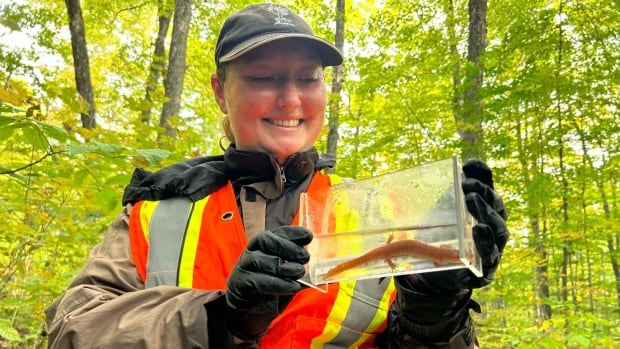Conservation groups in Quebec are trying to save a rare, endangered salamander before it’s too late. But the first step is finding the reclusive amphibian.
“It’s hours and hours of flipping rocks and then finally we find one. There’s always that joy,” said Laura Molina as she searched a cold creek near Saint-Ferdinand, Que., about 200 kilometres east of Montreal.
Molina is a project manager with Le Groupe de concertation des bassins versants de la zone Bécancour (GROBEC), a group that strives to protect the Bécancour river watersheds. Backed by the Quebec and federal governments, she has been counting the spring salamander population in the Chaudière-Appalaches region for about two weeks.
The colourful species can grow up to 23 centimetres long. It’s one of the largest salamanders without lungs or gills. It breathes through its skin, and can live up to 10 years.
Environment and Climate Change Canada published a spring salamander management plan in 2013, describing it as a large stream salamander found in the Appalachian Mountains. It is at the northern limit of its range in southeastern Quebec.
A conservation group in Quebec is trying to save the spring salamander by counting them and learning how they live. The province says it also has a plan to help this endangered species.
The species is also known to have lived in the Niagara Peninsula in Ontario, but has not been observed there since 1877.
It lives in small, clear, cool, well-oxygenated streams with rocky bottoms and no fish — habitat requirements that are a limiting factor for the species, the report says.
1 salamander at a time
Under provincial and federal law, the spring salamander is considered vulnerable and endangered.
They are so rare, the province doesn’t even know how many live in Quebec. And as Molina points out, finding one takes persistence, knowing where to look and the perfect temperature.
“It’s very sensitive to temperature. It has to be cold. If it’s too hot, they don’t come out and they actually burrow down in the ground because their skin dries and they can’t breathe,” she said.

A study conducted about 10 years ago identified locations where the salamanders live, and that’s where Molina’s group is searching.
Along with counting this species, the group is counting other salamanders and looking for anything that may threaten the amphibian’s environment.
The group says 94 per cent of spring salamander habitats are on private land.
“It’s very special to find species that are rare,” Molina said. “And especially knowing that despite all the changes in the environment. I think it says something about the region, about how the region is taking care of the streams as well.”
Recovery plan says more study needed
In the province’s species recovery plan, published in 2021, it says gaps in knowledge remain, particularly regarding the status and trends of populations, as well as the extent and significance of threats to the species and its habitat.
By 2031, Quebec plans to further study the species, protect its habitat and identify what it needs to thrive. Finally, a communication strategy must be developed and implemented to ensure, among other things, the success of sound agricultural and forestry practices, the recovery plan says.

For now, the Quebec plan says the habitat requirements of the spring salamander are a limiting factor for its survival, as is its late sexual maturity.
The physiological constraint imposed by skin respiration limits the species’ dispersal ability and makes it particularly sensitive to any changes, degradation and loss of habitat.
“In Quebec, agricultural and forestry runoff, causing sediment input and water quality alteration, is considered the most significant negative impact on the species,” the recovery plan says.
“Other threats, with a moderate impact on populations, include water management and use, transport and service corridors and logging.”
In the meantime, steps are already being taken to ensure the salamander is protected.


